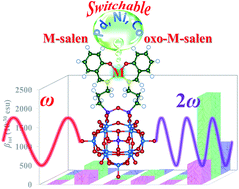Theoretical studies on oxidation-switchable second-order nonlinear optical responses of Metallosalen-Keggin polyoxometalate derivatives†
Abstract
To explore the effect of one-electron oxidation on nonlinear optical (NLO) responses, the frontier molecular orbitals, second-order NLO responses and electronic transition properties of three metallosalen–polyoxometalate compounds {SiW11O39[O(SiR)2M]}4− (R = (CH2)3N–CH(2-OPh); M = Pd, Ni and Co) (M-salen–POM) and their one-electron oxidized species were systematically investigated by density functional theory (DFT). Fukui function analysis shows that the M-salen is the oxidized center in M-salen–POM compounds. In addition, four functionals have been taken to confirm the switching behavior of the NLO properties by the one-electron oxidation. The βtot value of oxo-Pd-salen–POM is 98 times larger than that of Pd-salen–POM, indicating that the first hyperpolarizability is enhanced by one-electron oxidation. Time dependent (TD) DFT calculations show that the charge transfer from POM to M-salen, and intramolecular charge transfer within M-salen in oxidized species are beneficial to reduce the transition energy and improve the static first hyperpolarizabilities. The M-salen–POM may be a potential class of switchable nonlinear optical materials by one-electron oxidized processes.


 Please wait while we load your content...
Please wait while we load your content...